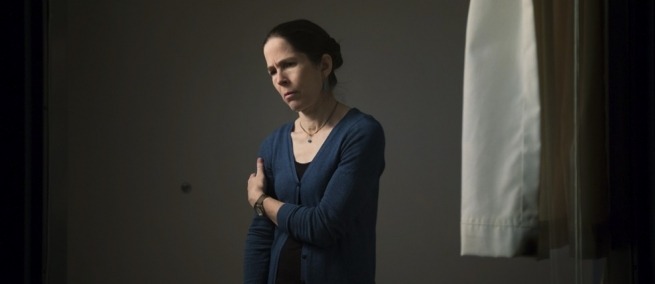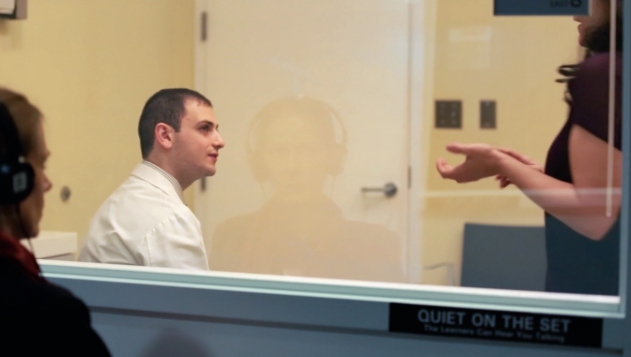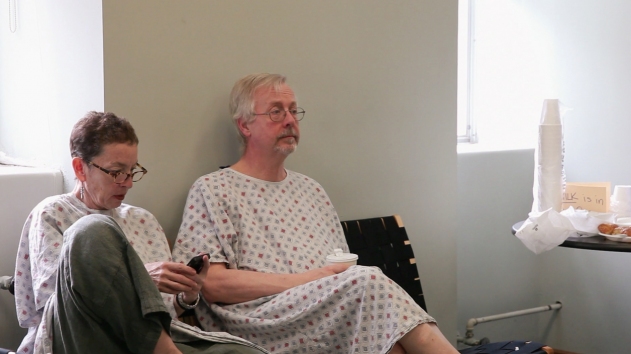
A doctor in training works with a “standardized patient” to practice his or her attitude toward a new patient. In the role of a standardized patient, an actor plays patient with a specific diagnosis that the doctor does not know in advance. These meetings are filmed and critiqued by medical professors. BEDSIDE MANNER is a new 18-minute documentary by Corinne Botz which focuses on this rehearsed aspect of the doctor-patient encounter. The film features Dr. Alice Flaherty, a neurologist and author who has herself been a real patient, standardized patient, and doctor. Science & Film spoke on the phone with Dr. Flaherty and Corinne Botz.
Science & Film: Corinne, how did you approach filming the simulated standardized patient and doctor interactions?
Corinne Botz: The central standardized patient simulation reverses the traditional medical gaze from the patient onto the student-doctors. The simulation is deconstructed in the following scene where Alice [Flaherty] is shown being trained to portray a delirious patient.
I structured the filming around Alice and the way that she moves between these different roles. It’s not a didactic film; I wanted the viewer to piece things together–to be part of the process of diagnosis, and try to understand what is real and what is not. How does the position from which we view something change how we construct reality?

S&F: The film depicts the doctor trying to relate to the patient. Alice, how do you think about empathy as both a doctor and a patient?
Alice Flaherty: I have a fraught relationship with empathy because on the one hand it connects people, but it can also cause a huge amount of suffering. If I hear a patient tell me about their back pain and I say, “I know exactly how you feel, my back pain is just like your back pain,” that is minimizing their pain. I find it a little more helpful to say, “I can’t imagine how painful that is.” Because we can never know what it’s like to be like another person.
CB: At the beginning of making this film, I was thinking about the patients’ point of view, and then through the process of shooting I started to feel empathy for the student doctor in terms of their vulnerability.
AF: Obviously the patients are suffering more than the medical students but the students really do suffer. Corinne has a great scene where one of the students comes out early from the standardized patient interview and the viewer doesn’t know what went wrong. He looks so distraught.
S&F: There is a scene in the film where the medical students are watching each other on screen interact with the standardized patients. It seemed really useful.
AF: Yes, when I was a med student we just got remedial bedside manner. That would have been so helpful to me. I think it really has made students better actors. I want to say actors because that’s what happened to me–I started acting more sympathetic and then I became more sympathetic.

S&F: What are you doing to study this in the brain?
AF: I’m writing a book about the neuroscience of empathy. There are some great researchers like Mohammadreza Hojat at Jefferson University who has shown how much medical students and residents’ empathic responses decrease as they become trained as doctors. There is a very important reason for that. Empathy really hurts. No one teaches students how to acquire affect tolerance.
S&F: Is bedside manner being taught now more now than when you were in school?
AF: It is being taught in a different way. We were taught by psychoanalysts, which was fascinating to me. Empathy is a neologism that was coined in 1905. The person who coined the term was actually an aesthetician; he was a philosopher of art. He was interested in a word that would describe how we feel something that somebody in a picture feels. Sympathy–a much more venerable term–has this huge component of helping somebody. Psychoanalysts jumped on the term empathy and appropriated it from art criticism because it fit that idea that they should not be directly helping their patients, but should be helping their patients to help themselves. A psychiatrist said to me while I was in training, “don’t just do something, sit there.” I was trained in a much more interventionist way and that was very hard for me. It’s important to learn how to just sit there and let the patient get through something rather than to step in and try to fix it. On the other hand, it can be taken to an extreme. When we were learning bedside manner we were instructed not to express too much sympathy because it is patronizing. That for me was very disturbing and it totally alienated all the surgeons who can’t bear to just sit there.
Now students learn techniques such as to say, “that must be hard for you.” That seemed like a cheap phrase when I first learned it but it actually makes people feel better. The first time I had to use it, I was appalled that I couldn’t think of anything better to say. But then the patient looked so grateful and he relaxed. Learning these strategies which may seem like false consolation to a psychoanalyst gives the rest of us who want to be more interventionist something to do and makes us feel less powerless when we’re faced with someone in incredible pain. Students learn a lot faster now with the standardized patients, I think.
S&F: Do you think showing Corinne’s film can effectively increase empathy?
AF: There is a tension around how we feel for those people in the film; is that actual empathy? Is it empathy we should be feeling for people in the real world where we can actually help them?
CB: I thought about real empathy versus photographic/filmic empathy while working on this project. Due to the nature of simulations, I hope the imagery both elicits and circumscribes an emotional response for viewers.

S&F: I think that empathy is a very over-used term in the film world; it is often used in talking about virtual reality. A lot of projects are based on putting the viewer in horrible and distressing situations in order to supposedly increase their empathy.
AF: That makes people shut down or run away. Empathy is partly self-protective. If everybody in the room is vomiting, you want to vomit too because probably what you ate was toxic. But if everybody in the room is screaming in pain the sensible thing to do is to get out of there.
S&F: From a scientific perspective, what part of the brain is associated with empathy?
AF: Mirror neurons are in the brain, and they were first studied in monkeys. Mirror neurons were found in the monkeys’ motor cortex and the neurons fire when the monkey is reaching for something and when the monkey sees another monkey reaching for something. So, they tend to make you want to do the same thing you’re watching someone else doing. That turns out to be hugely important for learning. A lot of how we learn is empathy. When you’re weeping, my eyes fill with tears too. And then, there’s another part of our brain that says, oh, I’m weeping, I must be sad. So empathy works in this weird way through acting. The acting comes first.
S&F: Corinne and Alice, have you presented the film together?
CB: Yes. It’s been a lot of fun travelling around with Alice.
AF: I keep thinking that we should start doing grand rounds and bring the film into my world of doctors. What’s interesting is that film is very unlike what they usually are exposed to. They’re used to watching NOVA documentaries, which are very clear-cut. When I met Corinne I thought she was going to make a straightforward film, but it’s so cool that she made something that has all this nuance and tolerance for ambiguity that medicine tries to stamp out.
BEDSIDE MANNER, directed, produced, filmed, and edited by Corinne Botz, won the Grand Jury Prize for best short film at DOC NYC in 2016. The film will play at the Dutch International Science Film Festival in November of 2017. Dr. Alice Flaherty, a neurologist at Massachusetts General Hospital and a professor of neurology and psychiatry at Harvard Medical School, has a forthcoming book about research into the neuroanatomy of empathy.
For more, watch Giacomo Rizzolatti, who helped discover mirror neurons, interviewed by Nobel Laureate neuroscientist Eric Kandel on a special edition of the Charlie Rose Show.